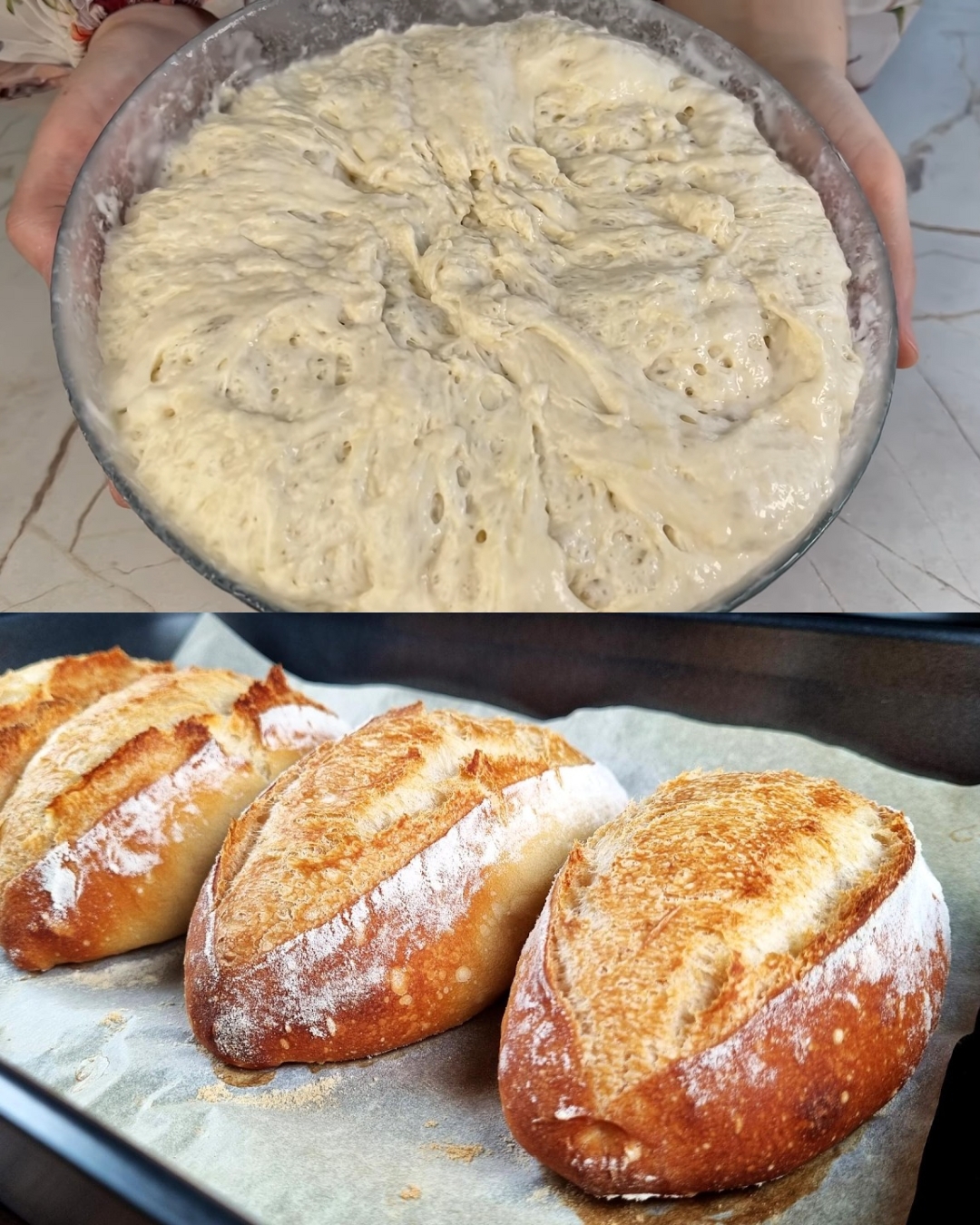Bread is a staple in many households around the world, and this Homemade Crusty Bread recipe delivers the perfect loaf. With its golden, crispy crust and soft, airy interior, it’s the ideal bread for any occasion. Whether you’re making a classic sandwich, enjoying it with soup, or simply savoring a warm slice with butter, this bread is both comforting and versatile. The dough is made with simple ingredients like yeast, flour, and salt, and the process involves rising, folding, and baking to create the perfect texture. What makes this bread particularly special is its ability to form a crispy exterior while maintaining a soft and fluffy inside. Baking this loaf at home also fills your kitchen with the irresistible aroma of freshly baked bread, creating a welcoming and warm atmosphere.
Preparation Time:
- Prep Time: 1 hour 30 minutes (includes rises and resting time)
- Cook Time: 30 minutes
- Total Time: 2 hours
- Servings: 6 loaves
Ingredients:
- 1 tbsp sugar
- 1 tsp dry yeast
- 250 ml lukewarm water (1 cup)
- 450 g flour (about 3 1/2 cups)
- 1 tsp salt (3 g)
Directions:
-
Activate the Yeast:
- In a large mixing bowl, combine lukewarm water, sugar, and dry yeast. Stir and let it sit for 5-10 minutes until the yeast becomes frothy. This is the crucial step to ensure that the yeast is active and ready to make the dough rise.
-
Mix the Dough:
- Once the yeast has activated, add flour and salt to the yeast mixture. Stir the ingredients together with a spatula until the dough starts coming together.
-
First Rise:
- Cover the bowl with a clean towel and set it in a warm place. Let the dough rest for about 30 minutes. During this time, the yeast will work, and the dough will begin to rise.
-
Stretch and Fold:
- After the first rise, wet your hands and gently stretch the dough from each of the four sides, folding it towards the center after each stretch. This process helps to develop the gluten and makes the bread chewy and airy.
- Cover the dough again and let it rest for another 30 minutes. After the second resting period, repeat the stretching and folding process for even better texture.
-
Final Rise:
- Cover the dough one more time and let it rise in a warm spot until it doubles in size. This should take about 30-60 minutes. When it’s ready, it will be soft and puffy.
-
Shape the Dough:
- Sprinkle some flour onto your work surface and divide the dough into 6 equal portions. Shape each piece into a ball, flatten it slightly, and then roll it into a loaf shape. This ensures each loaf rises evenly during baking.
- Place the loaves onto a baking tray lined with parchment paper.
-
Final Proofing:
- Cover the loaves with a clean towel and let them rise for an additional 30 minutes. This final rise ensures the loaves are light and fluffy once baked.
-
Bake:
- Preheat your oven to 450°F (230°C). When the oven is ready, score the tops of the loaves with a sharp knife or razor blade. This helps the bread expand properly while baking.
- Sprinkle some flour over the loaves, splash with water for steam, and cover them with a baking tray or lid.
- Bake the loaves for 20 minutes with the tray or lid on. Then, remove the top and bake for another 10 minutes until the loaves are golden brown and crisp.
-
Cool and Serve:
- After baking, let the loaves cool on a wire rack before slicing. This helps the bread set properly and ensures a perfect texture.
Nutritional Facts (per serving):
- Calories: 120 kcal (per slice)
- Carbohydrates: 25 g
- Protein: 4 g
- Fat: 0.5 g
- Fiber: 1 g
- Sugar: 2 g
- Sodium: 250 mg
The Origins and Popularity of Homemade Bread (300 words):
The origins of bread date back thousands of years, with the first traces of bread found in ancient civilizations like Egypt and Mesopotamia. Bread was historically made by grinding grain into flour, mixing it with water, and letting the natural fermentation process take place, making it an accessible and staple food for many cultures. Over time, bread-making techniques evolved, with advancements in technology allowing for quicker, more efficient bread production.
In today’s world, bread remains a crucial part of various cuisines around the globe, with countless varieties made in homes, bakeries, and factories. Homemade bread, however, is making a comeback, especially in the wake of the modern desire for clean eating and more homemade, natural foods. The process of making bread from scratch is both therapeutic and rewarding, as the bread’s flavor improves with every rise, fold, and bake.
Making bread at home allows bakers to customize their recipes, using a range of flours, herbs, and other flavoring agents. The process also allows for more control over the quality of ingredients, such as opting for organic flour, adding whole grains, or excluding preservatives commonly found in store-bought bread. Additionally, the bread-making process itself provides a deeper connection to traditional cooking techniques that have been passed down for generations.
As more people are exploring the art of bread-making, recipes like this Homemade Crusty Bread serve as an easy and fulfilling way to produce high-quality bread without needing specialized equipment or experience. The popularity of sourdough, no-knead, and artisan breads has also increased, as home bakers experiment with different flavors and textures, further cementing the trend of making bread from scratch in the modern culinary landscape.
Why You’ll Love This Recipe:
- Simple Ingredients: This bread requires only a handful of basic ingredients, all of which are commonly found in most kitchens. The simplicity of the recipe makes it perfect for bakers of all skill levels.
- Easy to Follow: With straightforward directions and no complicated techniques, this recipe offers a beginner-friendly approach to making crusty bread at home.
- Golden Crust & Soft Interior: The combination of a crispy, golden crust and a soft, airy interior is what sets this bread apart, making it incredibly satisfying to bake and eat.
- Customizable: You can add herbs, garlic, cheese, or seeds to the dough to suit your preferences, making it versatile and adaptable to various occasions.
- Fresh & Homemade: Nothing compares to the smell and taste of freshly baked homemade bread. Enjoy the satisfaction of making something from scratch that can be used in a variety of meals.
Health Benefits of Homemade Crusty Bread:
- Higher Nutritional Value: Making your own bread gives you control over the ingredients, meaning you can opt for whole wheat flour or alternative grains, which are higher in fiber and nutrients than typical white bread.
- No Preservatives: Homemade bread contains no artificial preservatives or additives, making it a healthier choice for those looking to minimize processed foods.
- Rich in Carbohydrates: Bread is a great source of complex carbohydrates, which are essential for energy, especially for active individuals or those needing a quick source of fuel.
- No Added Sugar: This recipe contains minimal added sugar (only 1 tablespoon), allowing the bread to maintain a natural flavor without excessive sweetness.
Serving Suggestions:
- Breakfast: Enjoy a warm slice of this bread with butter, jam, or peanut butter for a hearty breakfast.
- Side Dish: Serve as a side with soups, stews, or salads to add texture and richness to the meal.
- Sandwiches: Use it to make classic sandwiches, filled with your favorite meats, veggies, and condiments.
- Toast: Toast slices of this bread and top with avocado, eggs, or your choice of toppings for a delicious, satisfying snack.
Tips:
- Steam for a Crustier Loaf: When baking, adding a little steam to the oven (by placing a tray of water at the bottom) can create a crispier crust.
- Don’t Skip the Rises: The resting periods are essential for the bread’s flavor and texture, so don’t rush them.
- Use High-Quality Flour: Opt for bread flour or high-protein flour for the best results, as it will create a dough that can rise better and result in a fluffier loaf.
- Preheat the Oven: Ensure your oven is fully preheated before placing the loaves inside to create the perfect rise and crust.
Variations to Try:
- Herbed Bread: Add rosemary, thyme, or garlic to the dough for a flavorful, aromatic twist.
- Seeded Bread: Add sunflower seeds, sesame seeds, or pumpkin seeds to the dough for added crunch and flavor.
- Whole Grain: Substitute half of the white flour with whole wheat flour for a denser and more fiber-rich loaf.
- Cheese Bread: Incorporate grated cheddar or parmesan into the dough for a cheesy, savory loaf.
Conclusion:
This Homemade Crusty Bread is the perfect addition to any meal or occasion. Whether you enjoy it with a warm bowl of soup, as a sandwich, or simply on its own, it’s a versatile and satisfying bread that is sure to impress. By making this bread from scratch, you not only control the ingredients but also enjoy the process of creating something from start to finish. So grab your apron, get baking, and enjoy the delicious, comforting satisfaction of homemade bread!
Frequently Asked Questions (FAQs):
-
Can I use instant yeast instead of dry yeast?
Yes, you can use instant yeast, but you don’t need to activate it in water. Just mix it directly with the dry ingredients. -
Can I freeze the dough?
Yes, you can freeze the dough after the first rise. Just shape it into loaves, wrap tightly, and freeze for up to 3 months. Let it thaw and rise before baking. -
How do I know when the bread is fully baked?
When the bread is golden brown and sounds hollow when tapped on the bottom, it’s done. If you want to be sure, use a thermometer—190°F (88°C) in the center of the loaf is the perfect temperature.
Enjoy your delicious, homemade crusty bread!

